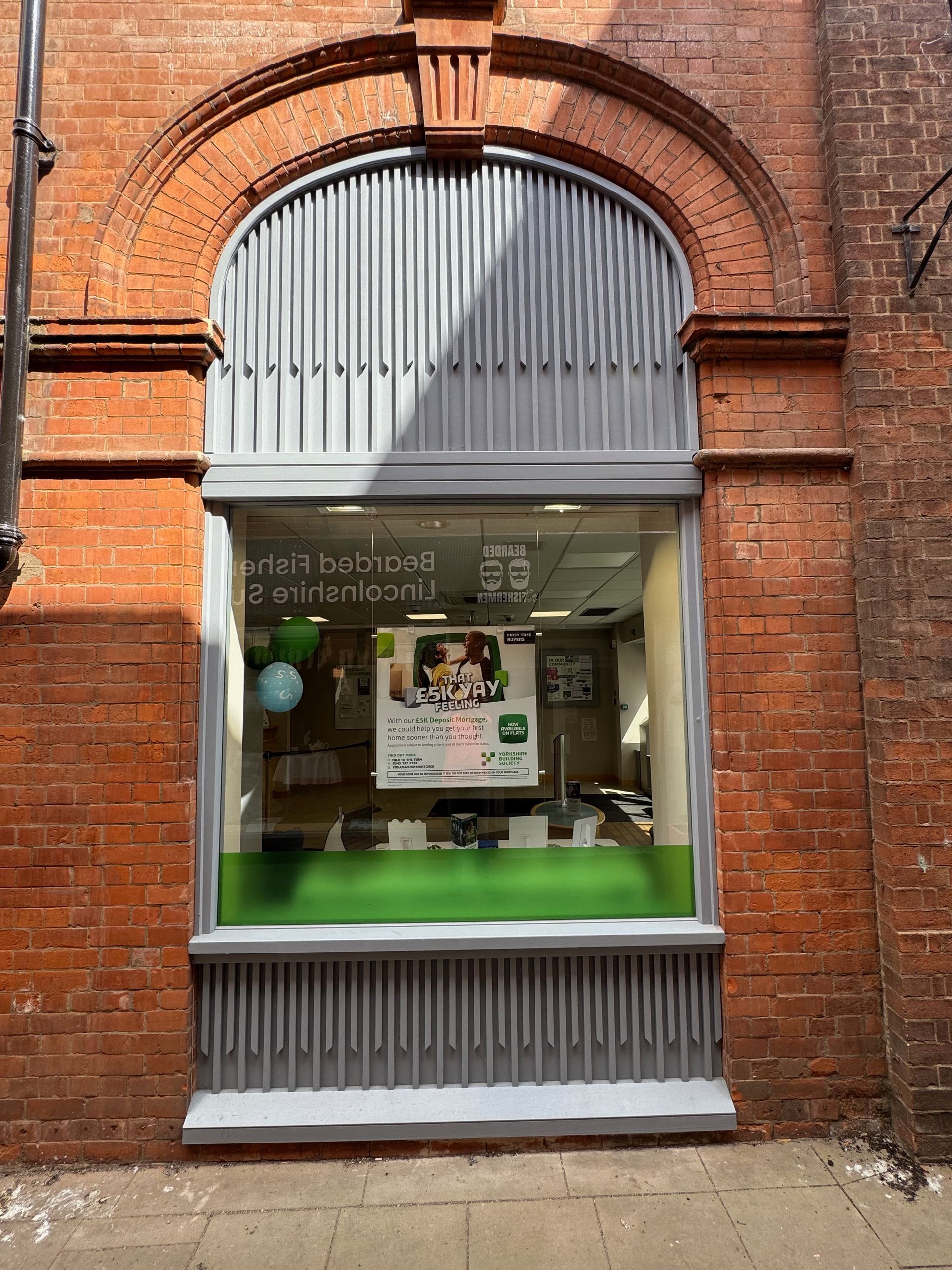Bespoke Sapele Hardwood Shopfront, Yorkshire Building Society, Gainsborough
Beautifully Restored Historic Shopfront
This was a very challenging shopfront replacement with the tenants being a Bank/Building Society, security was by far the most important factor. This meant that the work had to take place out of normal working hours. Fortunately this particular branch does not open on a Saturday so we were fortunate enough to have a full weekend to install the new shopfront. Like Alfie’s this was a single entrance door but we were a little limited as to the position of it due to the internal floor levels and finishes. We also had the extra job of re-fitting a fire retardant letter box which required an exact opening to be cut out of one of the glazing panels this meant a millimetre perfect template was made and sent to the glazers for this to be manufactured.
YBS also had strict regulations for locking systems and opening systems, we worked with their nominated contractors in order to complete this seamlessly.
To add to this we also had 3 new windows to manufacture and fit for YBS to the Flag Alley elevation. These were deisnged and manufactured to blend in with the new shopfronts. The detailing was carefully made to make sure that the flow followed on from the Market place elevation. Again this work had to be carried out when the branch was closed, another weekend of intense but ultimately rewarding work! Finally the YBS corporate branding was incorporated onto the front fascia with a mix of vinyl logo and hand painted lettering.

What Is Sapele?
Sapele is an African hardwood.
Sapele (scientific name: Entandrophragma cylindricum) is a tropical African hardwood native to the rainforests of West Africa. It is usually pronounced suh-pee-lee, although suh-pell-ee isn’t uncommon. Other common names include sapelli, sapeli mahogany. The species gets its name from the Nigerian city of Sapele.
The species has a widespread growth range across tropical Africa, with significant populations in Congo, Ghana, Tanzania and Nigeria. The trees grow exceptionally tall and straight — up to 45 metres in height, and around 2 metres in diameter with almost no branching — lending it well to wider, longer lengths with good yield per log, with very few defects.
Colour
Sapele is a type of timber whose colour darkens with age. The heartwood deepens to an elegant, rich and magnificent dark reddish-brown. Expect to see an iridescent mixture of light pinks, reds, browns and golds, too. This prized colour mimics mahogany — both timbers are part of the Meliaceae family. Many high-end joiners are flocking to sapele as a more sustainable, cost-effective alternative to genuine mahogany.
Grain
Sapele’s grain pattern is close, woven and interlocking — its fibres twist tightly as they grow, aligning in opposite directions. This often produces eye-catching ribbon-like patterns on sawn boards.
It’s also common to find sapele with figuring. These are special markings produced in the wood grain. Fiddleback, quilted, wavy, beeswing, swirl, mottled and pommel figuring can all occur in sapele. The cause of wood figuring is much debated, but it’s believed to be the result of genetic deviation, bacterial infection or environmental stresses. It certainly provides a decorative, sought-after look.
Density
Sapele grows slowly, making it incredibly dense, heavy and scratch resistant, clocking in at a mighty 640kg/m³.
The wood has a Janka hardness score of 6,700 N, greater than genuine mahogany, white oak and teak. Janka score refers to the force required to implant a small steel ball halfway into a sample of wood.
Along with wenge (7,300 N) and zebrano (7,010 N), sapele is one of the strongest woods that is also widely commercially available. It has high resistance to knocks, bending and indentation.
Outdoor durability and stability
Sapele has very good natural resistance to moisture, rot and insects. Whilst treatment is recommended to lengthen the lifespan, it can withstand being left outdoors without a finish. Sapele’s commendable density also means it’s well suited to withstand knocks, bumps and scrapes that might occur outside.
Sapele’s density, hardness and propensity for straight-grained boles (the trunk centre) make it very stable and predictable throughout its lifespan as a timber product.
Workability
Sapele produces good results when turning, glueing and finishing, although it can have a blunting effect on tools. Due to its interlocking grain pattern, sapele can be prone to tearout when machining.
Sapele: uses
- Furniture and cabinetry: Coffee tables, chairs, drawers, bed frames, desks — sapele’s workability, scratch-resistance and elegant, mahogany-esque appearance make it a time-honoured favourite for all types of high-end joinery. Sapele is also used in the manufacture of veneers.
- Flooring: For a luxury project, sapele steps up superbly. Its reddish-brown tones provide opulence, with sapele’s superior density making it best placed to withstand the inevitable knocks, bumps and scrapes.
- Decking: Although there are more popular species for decking — hello, Iroko — sapele’s good looks, scratch resistance and outdoor durability make it equally well equipped to act as an exterior decking timber.
- Outdoor construction and furniture: This species can be used for exterior elements like window frames and doors, where the wood might be expected to withstand the elements to some degree. It’s also suitable for outdoor benches, tables, chairs, loungers, planters — you name it.
- Boatbuilding: Sapele’s natural water resistance and receptiveness to treatment means it takes to water with effortless ease and elegance.
- Musical instruments: Undoubtedly a more niche use, sapele’s acoustic properties nevertheless make it a popular choice for instruments. It is sometimes used for the back, sides and top of acoustic and electric guitars and for the neck piece of ukuleles and harps.
-
Sapele: sustainability
Given their prized physical properties, many populations of African hardwoods have been historically overexploited — that is, depleted faster than they can be replenished. Genuine mahogany, in particular, is at risk of becoming commercially extinct due to illegal logging and unsustainable export levels.
This is where sapele can help. Despite being listed as ‘Vulnerable’ in the IUCN Red List in 1998, there are thankfully now protected populations and restrictions on felling in many countries. Unlike genuine mahogany, sapele is not listed in the CITES Appendices.
It's crucial to buy yours from a merchant with a clear environmental commitment. We perform frequently traceability and sustainability checks on our suppliers – which even means trips to central Africa to survey our sapele stocks and the forest management practices.
Many operators have introduced strict verification and regulation schemes — buyers can request provenance documentation for peace of mind. Additionally, like all trees, sapele has carbon offset value. It sequesters carbon — a greenhouse gas — from the atmosphere during its lifespan.
When sourced from well-managed woodlands, sapele is verifiable, 100% renewable and sustainable, helping to curb unsustainable harvesting of other tropical timbers. The fact sapele grows tall and straight helps with yield per log, making it a very ‘efficient’ species.
Source: duffieldtimber.com





















